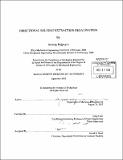Directional solvent extraction desalination
Author(s)
Bajpayee, Anurag
DownloadFull printable version (13.13Mb)
Other Contributors
Massachusetts Institute of Technology. Department of Mechanical Engineering.
Advisor
Gang Chen.
Terms of use
Metadata
Show full item recordAbstract
World water supply is struggling to meet demand. Production of fresh water from the oceans could supply this demand almost indefinitely. As global energy consumption continues to increase, water and energy resources are getting closely intertwined, especially with regards to the water consumption and contamination in the unconventional oil and gas industry. Development of effective, affordable desalination and water treatment technologies is thus vital to meeting future demand, maintaining economic development, enabling continued growth of energy resources, and preventing regional and international conflict. We have developed a new low temperature, membrane-free desalination technology using directional solvents capable of extracting pure water from a contaminated solution without themselves dissolving in the recovered water. This method dissolves the water into a directional solvent by increasing its temperature, rejects salts and other contaminants, then recovers pure water by cooling back to ambient temperature, and re-uses the solvent. The directional solvents used here include soybean oil, hexanoic acid, decanoic acid, and octanoic acid with the last two observed to be the most effective. These fatty acids exhibit the required characteristics by having a hydrophilic carboxylic acid end which bonds to water molecules but the hydrophobic chain prevents the dissolution of water soluble salts as well the dissolution of the solvent in water. Directional solvent extraction may be considered a molecular-level desalination approach. Directional Solvent Extraction circumvents the need for membranes, uses simple, inexpensive machinery, and by operating at low temperatures offers the potential for using waste heat. This technique also lends itself well to treatment of feed waters over a wide range of total dissolved solids (TDS) levels and is one of the very few known techniques to extract water from saturated brines. We demonstrate >95% salt rejection for seawater TDS concentrations (35,000 ppm) as well as for oilfield produced water TDS concentrations (>100,000 ppm) and saturated brines (300,000 ppm) through a benchtop batch process, and recovery ratios as high as 85% for feed TDS of 35,000 ppm through a multi-stage batch process. We have also designed, constructed, and demonstrated a semi-continuous process prototype. The energy and economic analysis suggests that this technique could become an effective, affordable method for seawater desalination and for treatment of produced water from unconventional oil and gas extraction.
Description
Thesis (Ph. D.)--Massachusetts Institute of Technology, Dept. of Mechanical Engineering, 2012. "September 2012." Cataloged from PDF version of thesis. Includes bibliographical references (p. 131-137).
Date issued
2012Department
Massachusetts Institute of Technology. Department of Mechanical EngineeringPublisher
Massachusetts Institute of Technology
Keywords
Mechanical Engineering.